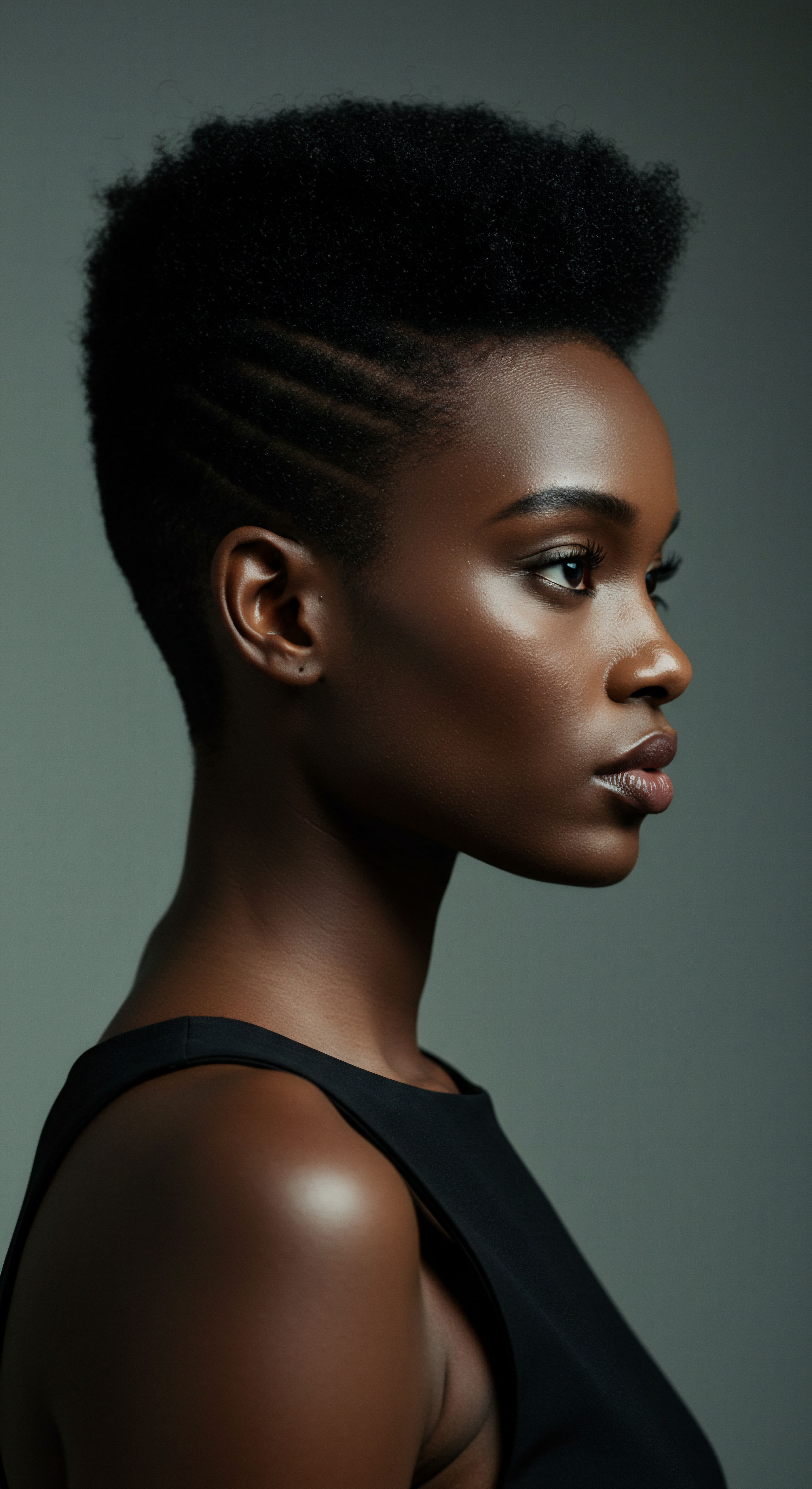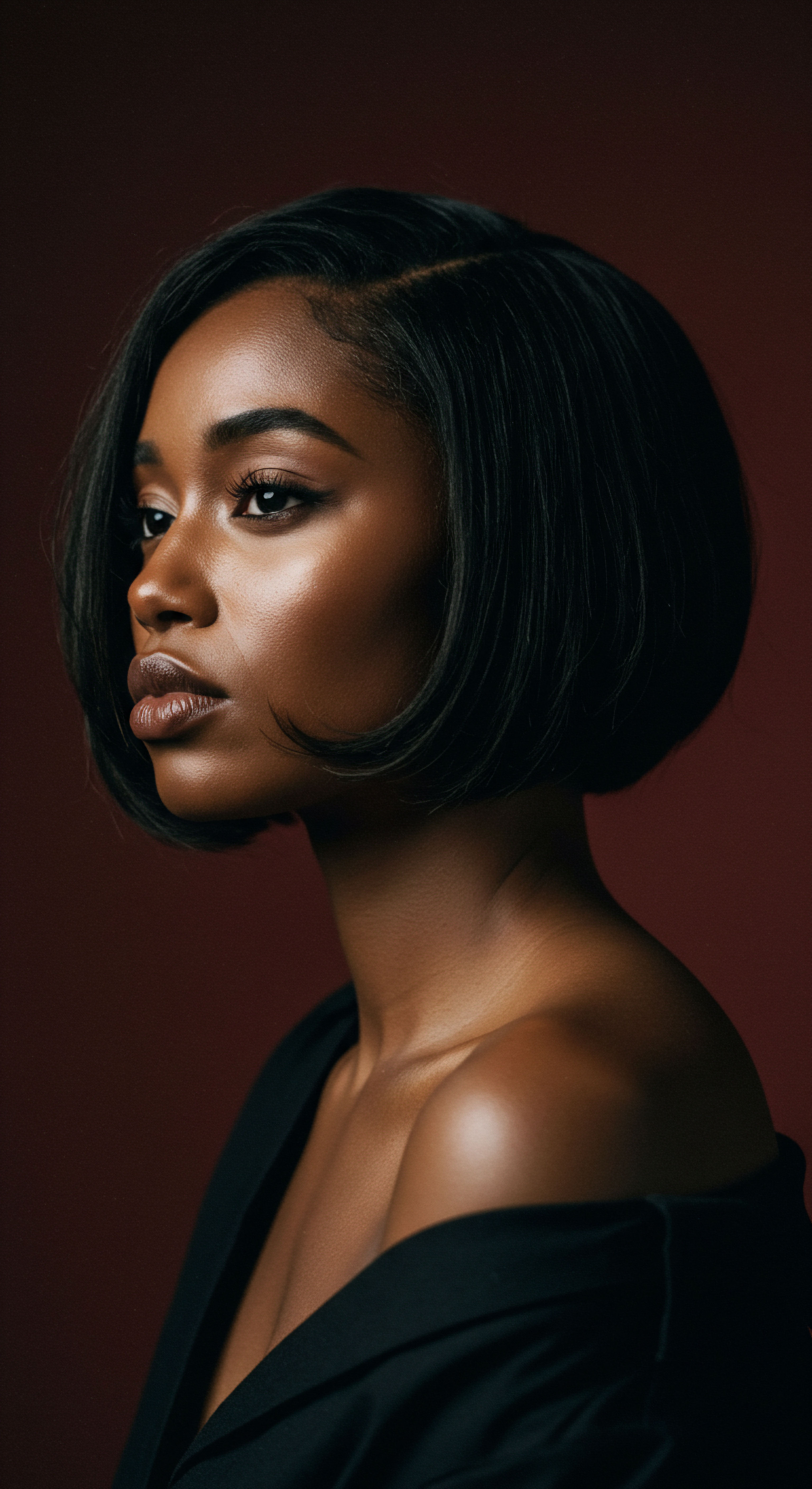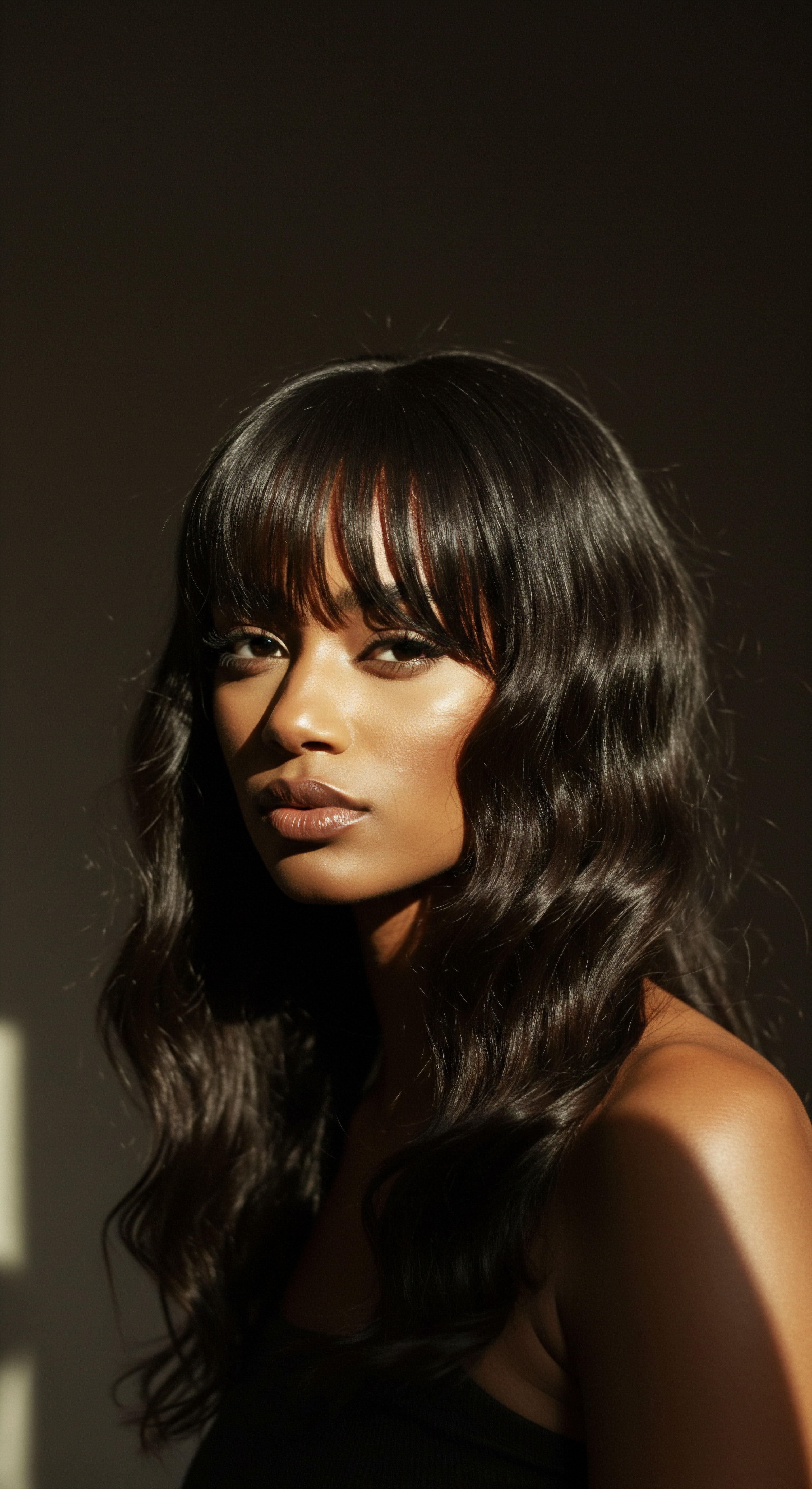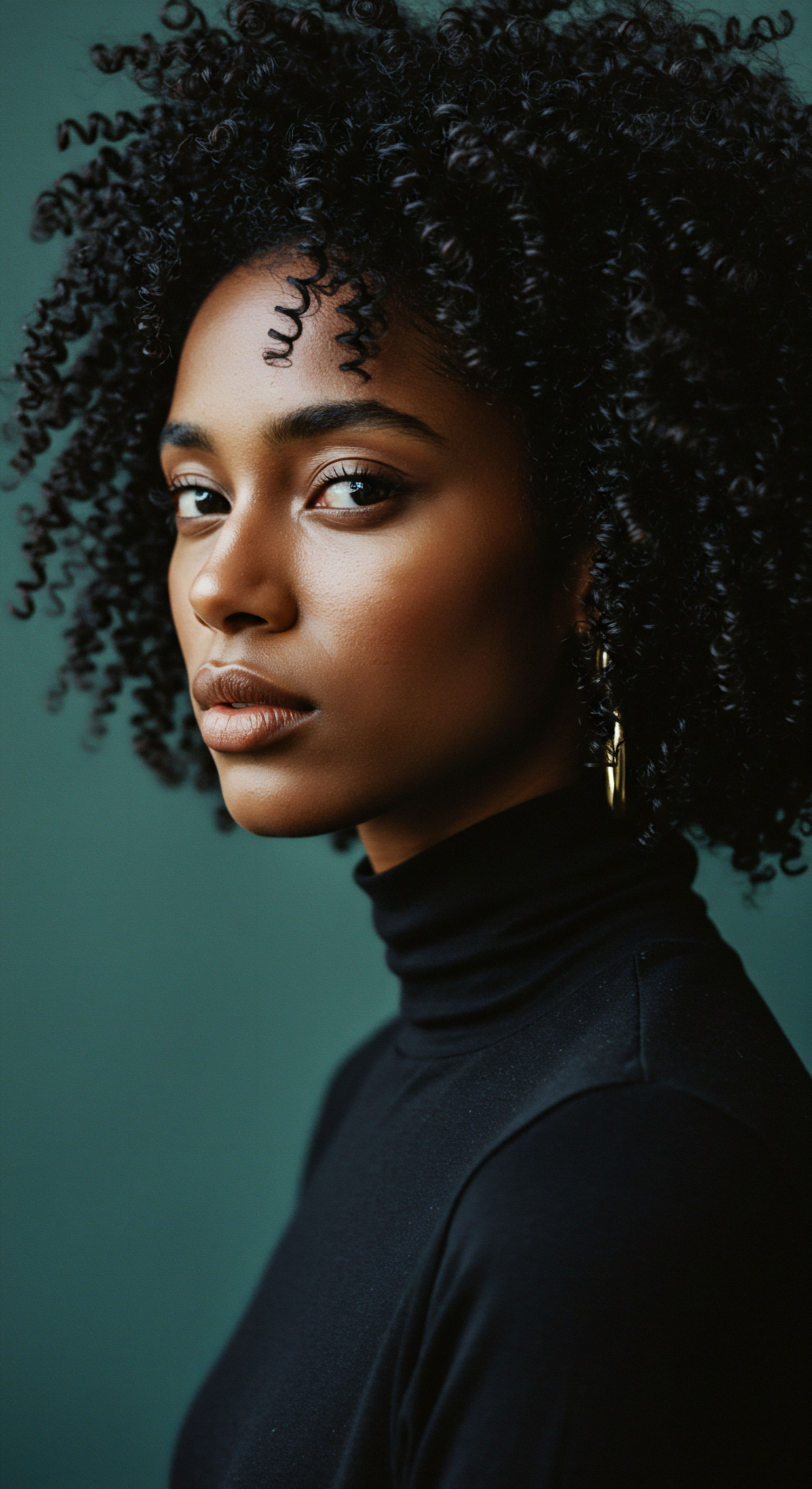
Roots
The journey to understanding our hair, particularly textured strands, often begins with a quiet observation of its response to the world around it. We notice the way moisture dances with a humid afternoon, or how a particular product lends a fleeting gleam. Within this realm of daily discovery, certain ingredients stand as quiet architects of our hair’s immediate feel, and among them, silicones hold a curious position.
These compounds, born from silica, a substance as fundamental as the sand beneath our feet, have been woven into the fabric of modern hair care, promising a touch of effortless smoothness and a radiant polish. Yet, beneath their shimmering veneer lies a deeper story, one that whispers of long-term hydration and the unique needs of our coils and curls.
Silicones, in their most basic form, are polymers, long chains of molecules. They appear in countless cosmetic formulations, from leave-in conditioners to styling serums, prized for their ability to create a film around each hair strand. This film offers an immediate, palpable difference ❉ a reduction in friction, a feeling of softness, and a reflective sheen that captures the light.
This initial impression, a visual and tactile promise of vitality, often overshadows the more subtle, enduring impact these ingredients might have on the hair’s intrinsic moisture balance. To truly appreciate their presence, we must look beyond the surface gloss and into the very nature of these versatile compounds.

The Different Faces of Silicones
Not all silicones behave in the same manner. Their chemical structures dictate how they interact with water and, by extension, how they might settle upon or depart from our hair. Understanding these distinctions becomes a guiding light for those seeking genuine, lasting moisture.
- Non-Water-Soluble Silicones ❉ These are the heavier, more persistent members of the silicone family. Compounds like Dimethicone and Cyclopentasiloxane form a more tenacious film on the hair shaft. This coating, while initially providing a sleek finish, does not readily rinse away with water alone. Their removal often necessitates stronger cleansing agents, such as shampoos containing sulfates. Over time, this can create a cycle where the very act of cleansing to remove the silicone might inadvertently strip the hair of its natural, vital oils, leading to a sensation of dryness.
- Water-Soluble Silicones ❉ These lighter variants, often identified by names like Dimethicone Copolyol or those with a ‘PEG-‘ prefix, are designed to dissolve in water. They offer many of the immediate cosmetic benefits of their non-soluble counterparts but rinse away more easily, reducing the likelihood of substantial accumulation. This characteristic makes them a gentler choice for routines that prioritize frequent washing or co-washing, aiming to avoid undue product residue.
- Evaporating Silicones ❉ Volatile silicones, including certain forms of Cyclomethicone and Cyclopentasiloxane, offer a temporary coating that dissipates into the air within a few hours of application. They lend a fleeting smoothness and shine without the concern of long-term residue, acting as transient aids in styling rather than enduring conditioning agents.
Each type presents a different relationship with the hair fiber, influencing how moisture is perceived and maintained over time. The choice of silicone, therefore, shapes not just the hair’s appearance in the moment, but its long-term hydration narrative.
Understanding the distinct types of silicones is essential, as their solubility dictates their interaction with hair and its long-term moisture.
The very structure of textured hair, with its unique coils and curves, presents a different canvas for these compounds. The natural oils produced by the scalp find it more challenging to travel down a coiled strand, leaving textured hair inherently more prone to dryness. A coating, whether light or heavy, interacts with this natural propensity for dryness in ways that are not always immediately apparent, but which subtly shape the hair’s enduring hydration.

Ritual
Our daily and weekly hair rituals are a dance between intention and response, a personal choreography of care. When we reach for a conditioner or a styling cream, we seek tangible results ❉ a smooth comb-through, a touch of gloss, a curl that holds its shape. Silicones, with their remarkable ability to deliver these immediate sensations, often become silent partners in these routines.
They provide that coveted “slip” that makes detangling a gentler process, and they can lend a visual vibrancy that speaks of health and vitality. This surface-level interaction, however, is but one layer of their influence.
The initial appeal of silicones lies in their functional elegance. They reduce friction between strands, which is a particular blessing for textured hair, prone to tangles and breakage. The film they form acts as a protective shield, offering a measure of defense against environmental elements like humidity, which can otherwise cause curls to expand and frizz.
This protective quality also extends to heat styling, creating a barrier that can mitigate some of the damage from thermal tools. For many, the instantaneous transformation—the softened feel, the enhanced sheen—makes silicones a seemingly indispensable component of their care regimen.

How Do Silicones Influence Daily Hair Behavior?
In the short term, silicones can be quite effective at managing the external appearance of textured hair. They can help seal the cuticle, creating a smoother surface that reflects light, resulting in a more polished look. This smoothing action also aids in defining curl patterns, offering a sense of control and cohesion to the hair. The ease of styling and the visible gloss contribute to a feeling of hair health and manageability, which can be deeply affirming for individuals navigating the unique characteristics of their textured strands.
Consider a morning styling routine ❉ a generous application of a product rich in dimethicone might yield perfectly sculpted coils, each one catching the light. The hair feels incredibly soft, almost silken to the touch. This immediate gratification can reinforce the belief that silicones are wholly beneficial, masking the subtle, long-term shifts in moisture dynamics that might be occurring beneath the surface.

What Are the Initial Moisture Dynamics?
Silicones, particularly the non-water-soluble types, function as occlusive agents. This means they form a hydrophobic, or water-repelling, barrier around the hair shaft. This barrier can indeed help to minimize moisture loss from the hair fiber, effectively “sealing” in the hydration that is already present. However, this same protective layer can also act as a formidable gatekeeper, potentially impeding the absorption of subsequent hydrating ingredients, such as water-based leave-in conditioners or deep treatments.
For textured hair, which naturally tends to be drier due to the winding path of sebum down the strand, this dual action presents a delicate balance. While silicones can prevent moisture from escaping, they can also prevent moisture from entering. This can lead to a deceptive scenario where the hair feels soft and looks shiny on the outside, but internally, it might slowly become dehydrated, especially if the hair is not adequately hydrated before silicone application, or if the silicones are not effectively removed.
Silicones offer immediate cosmetic benefits like smoothness and shine, yet their occlusive nature can subtly alter the hair’s long-term moisture absorption.
The choice to incorporate silicones into a hair ritual, therefore, becomes a conscious decision about balancing instant gratification with enduring hair health. It prompts a deeper inquiry into the types of silicones used, the frequency of their application, and the efficacy of the cleansing regimen designed to remove them. Without this mindful approach, the ritual intended to nurture might inadvertently contribute to a quiet, persistent dryness.

Relay
The true impact of silicones on textured hair’s long-term moisture is not always a sudden revelation; rather, it often unfolds as a subtle, persistent shift, a quiet deviation from its natural hydration equilibrium. To truly grasp this interplay, we must move beyond the immediate sensory experience and delve into the intricate relationship between these compounds and the unique architecture of textured strands. This exploration demands a careful examination of the science at play, the nuances of hair structure, and the lived experiences that shape our understanding.

How Do Silicones Influence Internal Hair Hydration?
At the heart of the matter lies the occlusive nature of many silicones, particularly the non-water-soluble varieties like Dimethicone. They form a film around the hair shaft, a hydrophobic layer that, while excellent at repelling water and humidity, can also create a barrier against the very moisture and nourishing ingredients our hair seeks. Textured hair, characterized by its varied curl patterns and often higher porosity, naturally possesses a cuticle layer that may be more open or raised in certain areas, making it more susceptible to moisture loss but also more receptive to external hydration.
When non-water-soluble silicones coat these strands, they can effectively seal the cuticle, preventing moisture from escaping. However, this seal can become a double-edged sword. If the hair is not sufficiently hydrated before the silicone application, or if the silicone layer becomes too thick due to repeated use without thorough cleansing, it can prevent subsequent water-based products, oils, or humectants from truly penetrating the hair shaft. This creates a deceptive scenario ❉ the hair might appear shiny and smooth on the surface, but beneath that exterior, it can become progressively drier, leading to internal dehydration.
This phenomenon is distinct from a simple “lack of moisture”; it speaks to a blockage of moisture uptake. The hair is, in essence, starved of hydration from the outside, even as it might be protected from external humidity. This can result in a brittle feel over time, reduced elasticity, and a propensity for breakage, despite the initial promise of softness and strength.

Can Silicone Application Alter Curl Patterns?
For individuals with textured hair, the long-term application of heavier silicones can subtly alter the natural curl pattern. The accumulation of these compounds can weigh down the hair strands, causing curls to lose their characteristic bounce and definition. What once were lively coils might appear elongated, limp, or less vibrant. This is not a chemical alteration of the hair’s internal structure, but rather a physical coating that adds weight and stiffness, preventing the hair from forming its natural, buoyant shape.
The need to remove this buildup often leads to the use of stronger clarifying shampoos, many of which contain sulfates. While effective at stripping away silicone residue, these cleansers can also strip the hair of its natural sebum and lipids, leaving it feeling even drier and more vulnerable. This cycle of applying occlusive silicones, experiencing buildup, and then resorting to harsh cleansers can exacerbate dryness and contribute to a feeling of perpetual moisture deficiency, a stark contrast to the healthy, hydrated state desired for textured hair.
Long-term use of non-water-soluble silicones can create a deceptive surface sheen while hindering true hydration and potentially altering natural curl patterns.

Do Vegetable Oils Offer a Different Path to Moisture?
In contrast to the occlusive action of many silicones, certain natural alternatives, particularly vegetable oils, interact with hair in a different manner, offering insights into alternative approaches to long-term moisture. A study conducted by Belleti et al. in 2018, comparing hair care formulations containing vegetable oils (specifically olive oil and Brazil nut oil) versus a silicone-based formulation (cyclomethicone), yielded notable distinctions in their effects on hair. The research indicated that formulations supplemented with vegetable oils significantly improved hair cuticles, leading to increased hair softness, hydration, and strength.
This positive outcome was not observed with the silicone formulation. The study concluded that vegetable oils could be a beneficial choice for developing hair care cosmetics aimed at improving gloss, softness, and resistance to breakage, highlighting their ability to truly enhance the hair’s internal structure and hydration, beyond just surface effects.
This particular research suggests that while silicones might offer surface lubrication and temporary shine, they may not contribute to the deeper, structural improvements in hair hydration and strength that certain natural oils can provide. The implication for textured hair is significant ❉ relying solely on silicones for moisture management might mean missing out on the profound, restorative benefits that ingredients capable of permeating the hair fiber can offer.
| Ingredient Category Vegetable Oils (e.g. Olive Oil, Brazil Nut Oil) |
| Mechanism of Action Can permeate hair fiber, contributing to internal hydration and cuticle improvement. |
| Observed Long-Term Effects (Belleti Et Al. 2018) Increased hair softness, hydration, and strength; improved cuticles; enhanced resistance to breakage. |
| Ingredient Category Silicones (e.g. Cyclomethicone) |
| Mechanism of Action Forms a hydrophobic film on the hair surface, providing lubrication and shine. |
| Observed Long-Term Effects (Belleti Et Al. 2018) Promoted surface lubrication and increased hair softness, but did not show significant improvements in hydration or strength. |
| Ingredient Category This table highlights a comparative study suggesting distinct long-term outcomes for hair treated with vegetable oils versus silicones. |
The cultural lens also offers a rich perspective on hair care. Throughout history, various cultures have relied on natural ingredients for hair health, often prioritizing deep nourishment and intrinsic strength over fleeting surface aesthetics. From the traditional use of Shea Butter in some African communities for deep moisture and protection against harsh environmental conditions, to the application of Camellia Oil in Japan for shine and manageability, these practices often center on ingredients that interact with the hair’s natural properties rather than forming an external barrier. These ancient wisdoms, passed down through generations, speak to a profound understanding of hair’s inherent needs for sustained vitality.
The dialogue surrounding silicones in textured hair care is complex, moving beyond simple pronouncements of “good” or “bad.” It requires a deeper scientific understanding of how these compounds interact with the hair’s unique structure, an appreciation for the long-term consequences of their use, and an openness to diverse, often ancestral, approaches to hair wellness.

Reflection
The exploration of silicones and their influence on textured hair’s long-term moisture unveils a fascinating interplay between immediate gratification and enduring vitality. Our strands, with their intricate spirals and thirst for hydration, often react to the world in ways that prompt us to seek quick solutions for softness and shine. Silicones, with their remarkable ability to deliver these surface-level benefits, can indeed offer a momentary sense of control and beauty. Yet, the quiet narrative that unfolds over time, a story of potential moisture occlusion and the subtle shifting of our hair’s natural equilibrium, urges us to look deeper.
To nurture textured hair authentically, we are invited to consider not only what our hair looks like in the moment, but how it truly feels from within, how it drinks in life-giving water, and how it responds to the gentle touch of truly permeating care. This perspective allows us to move beyond a simplistic ingredient list and into a holistic understanding of our hair’s needs, embracing practices that foster deep, sustained hydration. It is a gentle reminder that the most profound beauty often blossoms from a place of genuine understanding and patient, informed choices.

References
- International Journal of Trichology. (2019). Silicones in Hair Products ❉ What Does Science Say?
- Prose. (2021). The Truth About Silicones In Your Hair Care Products.
- Seppic. (2024). Tips to have the best formulation for textured hair.
- Natural Hair Growth. (2013). Water-soluble vs. Non-soluble Silicones Found in Hair Products.
- Orlando Pita Play. (2023). Haircare Rituals Around the World ❉ Exploring Global Traditions.
- Ruwaa Life. (2024). Tresses Through Time ❉ A Journey Through the History of Hair Care.
- Desert Botanicals. (2021). Silicones in Hair Care Products? Some Key Things to Know.
- Odele Beauty. (2023). Are Silicones Bad For Hair? Our Experts Weigh In.
- TréLuxe Team. (2025). The Ultimate Guide to Curl-Loving Ingredients ❉ How Nature & Science Work for Your Hair.
- Amazingy Magazine. (2024). A History of Haircare.
- Voyant Beauty. (n.d.). Ingredient Insight – Textured Hair Care.
- Kenra Professional. (2024). The History of Haircare ❉ How Past Practices Shape Modern Routines.
- Noughty. (n.d.). Lifting the Lid ❉ Haircare Myths Decoded – Silicones.
- 22 Ayur. (n.d.). The Ancient Natural Ways of Hair Care Across Continents.
- Sauce Beauty. (2019). The Truth About Silicones in Hair Products.
- Let’s Make Beauty. (2024). The Science Behind Effective Hair Care Ingredients.
- Medical News Today. (2025). Curly girl method ❉ Steps, benefits, and drawbacks.
- The Hair Fuel. (2023). SILICONES IN HAIR PRODUCTS – ALL YOU NEED TO KNOW.
- (2025). Curly Hair Formulation 101 ❉ A Guide to Moisture, Hold, and Curl Definition.
- Clinikally. (2023). Decoding the Silicone Debate ❉ Unraveling Its Role in Hair Care.
- The Institute of Trichologists. (n.d.). The Great Hair Myths.
- Living Proof. (n.d.). Is Silicone Bad For Your Hair? Our Experts Weigh In.
- Byrdie. (2024). Silicone for Hair ❉ Benefits and How to Use It.
- Otter Valley Trichology Clinic. (2021). Ingredients 101 – Sulphate, Paraben, and Silicones.
- Gavazzoni Dias, M. (2015). Hair Cosmetics ❉ An Overview. International Journal of Trichology, 7(1), 2-15.
- Healthline. (2020). Is Silicone Bad For Your Hair? The Effects of Silicone on Each Hair Type.
- Reddit. (2022). Misinformation on silicones ❉ r/curlyhair.
- Purnamawati, S. Indrastuti, N. Danarti, R. & Saefudin, T. (2017). The Role of Moisturizers in Addressing Various Kinds of Dermatitis ❉ A Review. Clinical Medicine & Research, 15(3-4), 75–87.
- Evo. (n.d.). Hydration Boost conditioner.
- Sethi, A. Kaur, T. & Malhotra, S. K. (2016). A Review of Moisturizers; History, Preparation, Characterization and Applications. MDPI Cosmetics, 3(4), 37.
- Cosmetics Ingredients. (n.d.). Cyclomethicone (Volatile Silicone).
- Belleti, R. et al. (2018). Development and efficacy evaluation of hair care formulations containing vegetable oils and silicone. International Journal of Phytocosmetics and Natural Ingredients, 5(9).
- Barel, A. et al. (2005). Effect of oral intake of choline-stabilized orthosilicic acid on skin, hair and nails in women with photoaging signs. Archives of Dermatological Research, 297(4), 147-153.
- Hims. (2025). Silicone in Hair Products ❉ Benefits, Drawbacks, and What You Need to Know.
- Medical News Today. (2022). Humectant ❉ Examples and benefits for skin, hair, and lips.
- Lodén, M. & Andersson, S. B. (1996). Lipid uptake and skin occlusion following topical application of oils on adult and infant skin. Journal of Investigative Dermatology, 107(4), 582-585.
- Matamá, T. et al. (2016). Human Hair and the Impact of Cosmetic Procedures ❉ A Review on Cleansing and Shape-Modulating Cosmetics. Molecules, 21(11), 1475.
- Zelenkova, G. & Lishnevsky, L. (2025). Silicones in Cosmetics. In Silicones in Everyday Life (pp. 1-17). Springer.
- Hair by L’Oréal Professionnel. (2024). Is Silicone Bad for Hair and Health? The Effects of Silicone on Each Hair Type.